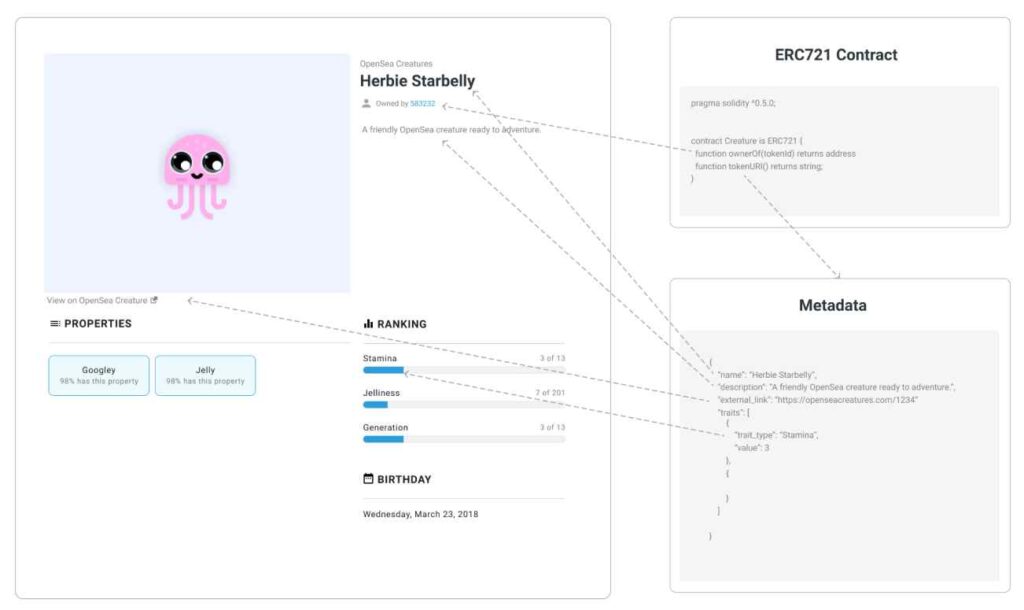Unlocking the Power of NFTs
Imagine purchasing a luxury watch with a stunning design, only to hesitate because of concerns about counterfeits. What if the seller could offer you a digital certificate securely stored on the blockchain, verifying the watch’s authenticity?
This is where non-fungible tokens (NFTs) come into play.
NFTs, often associated with digital art and collectibles, are expanding into real-world applications. They now serve as a secure method of proving ownership for physical assets like art, property, and even vehicles. In this article, we’ll explore how NFTs are reshaping ownership, their potential applications, and the benefits they bring to securing physical assets.
What Are NFTs, and Why Do They Matter?
NFTs, or non-fungible tokens, are unique digital assets stored on a blockchain. Each token contains metadata that distinguishes it from others, making NFTs one-of-a-kind. Unlike cryptocurrencies like Bitcoin or Ethereum, which are interchangeable (fungible), NFTs represent exclusive ownership of an asset, whether digital or physical.
The blockchain foundation of NFTs offers unparalleled transparency and efficiency in verifying ownership. These tokens provide instant proof of authenticity and eliminate the need for intermediaries. Thanks to blockchain’s immutability, ownership records stored as NFTs cannot be tampered with, ensuring a reliable and transparent system for verifying rights to assets.
This unique capability makes NFTs an ideal tool for tokenizing physical assets.

Tokenizing Physical Assets: How It Works
Tokenizing a physical asset means creating a digital representation of it on the blockchain. Essentially, it’s like granting the asset a digital passport. The resulting NFT serves as proof of authenticity and ownership, linking the asset to its tokenholder.
For instance, a car owner could tokenize their vehicle by creating an NFT that captures details such as the make, model, and VIN number. This digital record would then act as a secure and transparent certificate of ownership.
Advantages of Tokenizing Physical Assets:
- Transparent Provenance: Blockchain provides an unalterable history of ownership.
- Enhanced Security: Ownership records are safeguarded against fraud.
- Seamless Transfers: Transferring ownership of assets becomes as simple as transferring the NFT.
Linking NFTs to Physical Items
To associate an NFT with a physical item, unique identifiers must be embedded in the NFT’s metadata. These identifiers can include serial numbers, QR codes, photographs, or detailed descriptions of the item’s characteristics.
Additionally, the physical item may need to carry a corresponding identifier—like a scannable QR code or tamper-proof tag—that links it to the NFT. This dual-layer approach ensures a verifiable connection between the digital token and the physical object.
For example, in real estate, an NFT could be tied to a property’s title deed. The deed’s unique details, such as the address and registration number, would be recorded in the NFT’s metadata. When the NFT is transferred, ownership of the physical property follows, provided legal requirements are met.

Applications of NFTs for Real-World Ownership
NFTs are transforming ownership across industries, providing secure, transparent, and innovative solutions. Here are some key examples:
1. Real Estate
Platforms like Propy are leveraging NFTs to tokenize properties, enabling faster ownership transfers, fractional ownership, and international transactions.
2. Luxury Goods and Art
Platforms such as Artory use NFTs to verify the authenticity of luxury items and artwork. Buyers receive secure, blockchain-based proof of ownership.
3. Fractional Ownership of High-Value Assets
NFTs enable shared ownership of expensive assets like vacation homes, yachts, or even cars. Companies like PropiChain tokenize real estate, making high-value investments more accessible through fractional ownership, all while ensuring transparency and security.
4. Automotive Industry
NFTs simplify car ownership by tracking vehicle details such as maintenance history and upgrades. Platforms like Eloop, in collaboration with Peaq, tokenize cars for shared ownership, allowing individuals to co-own and benefit from shared usage and revenue.
5. Intellectual Property
NFTs offer a secure, tamper-proof method for managing patents, copyrights, and trademarks, enabling seamless transfers and verification.
These innovations are breaking down barriers in international ownership, reducing costs and complexity while enhancing transparency. With blockchain technology, tracing an asset’s history—from its origin to its current owner—is more straightforward than ever.
Legal Considerations
While NFTs offer significant advantages, the legal framework for using NFTs as proof of ownership is still evolving. In some jurisdictions, blockchain-based records are recognized as legitimate, but traditional legal documents like deeds or contracts often remain essential for completing ownership transfers, especially in regulated industries.
It’s crucial for businesses and individuals to understand that NFTs typically act as a supplementary proof of ownership rather than a replacement for legal documentation. Ensuring compliance with existing regulations is key to fully leveraging NFTs in asset management.
Conclusion
NFTs are revolutionizing ownership, offering secure, transparent, and efficient solutions for managing physical assets. By combining blockchain technology with innovative applications, NFTs are simplifying complex ownership processes and opening new doors for asset management.
From luxury goods to real estate, the potential of NFTs as proof of ownership is only beginning to unfold, transforming how we think about and secure what we own.















Leave a comment